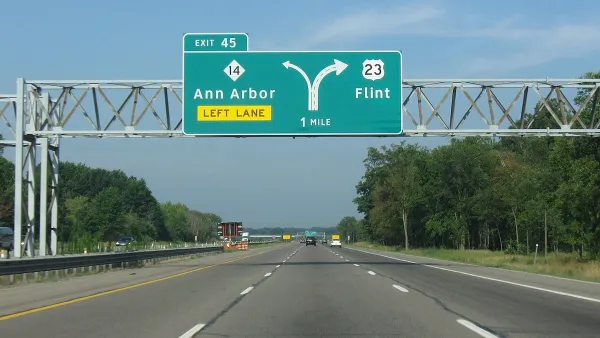The Michigan Department of Transportation will start a $1 billion, 14-year construction project later this year, on I-75, north of Detroit. Some community members are still wondering if the project is necessary.
Eric. D. Lawrence reports on the looming plans to widen the I-75 freeway outside of Detroit. "The project will modernize interchanges, replace all vehicle and pedestrian bridges and add a lane north and south to be used for carpooling during rush hour and regular traffic at other times," according to Lawrence.
Much of the focus of the article is devoted to the lingering questions about the wisdom of the 14-year, $1 billion project:
The initial reaction to the project has been mixed. Some are pleased that a major highway with obvious signs of wear and tear over the past five decades is finally getting rebuilt. Others suggest widening the more than 17-mile route from Auburn Hills to Hazel Park is an outdated approach to regional planning that would divert attention and resources from public transit.
The article includes soundbites from opponents to the project as well as the Michigan Department of Transportation. The latter insists the project is a "fix-it-first" project. Lawrence also devotes attention to the construction schedule, which splits the project into eight separate sections, and the funding allocations. The federal government is funding 80 percent of the final bill for the project. But most of the article's in-depth coverage details the political conversation occurring in response to the project.
FULL STORY: I-75: Mixed feelings on the $1B project

National Parks Layoffs Will Cause Communities to Lose Billions
Thousands of essential park workers were laid off this week, just before the busy spring break season.

Retro-silient?: America’s First “Eco-burb,” The Woodlands Turns 50
A master-planned community north of Houston offers lessons on green infrastructure and resilient design, but falls short of its founder’s lofty affordability and walkability goals.

Delivering for America Plan Will Downgrade Mail Service in at Least 49.5 Percent of Zip Codes
Republican and Democrat lawmakers criticize the plan for its disproportionate negative impact on rural communities.

Test News Post 1
This is a summary

Test News Headline 46
Test for the image on the front page.

Balancing Bombs and Butterflies: How the National Guard Protects a Rare Species
The National Guard at Fort Indiantown Gap uses GIS technology and land management strategies to balance military training with conservation efforts, ensuring the survival of the rare eastern regal fritillary butterfly.
Urban Design for Planners 1: Software Tools
This six-course series explores essential urban design concepts using open source software and equips planners with the tools they need to participate fully in the urban design process.
Planning for Universal Design
Learn the tools for implementing Universal Design in planning regulations.
EMC Planning Group, Inc.
Planetizen
Planetizen
Mpact (formerly Rail~Volution)
Great Falls Development Authority, Inc.
HUDs Office of Policy Development and Research
NYU Wagner Graduate School of Public Service





























